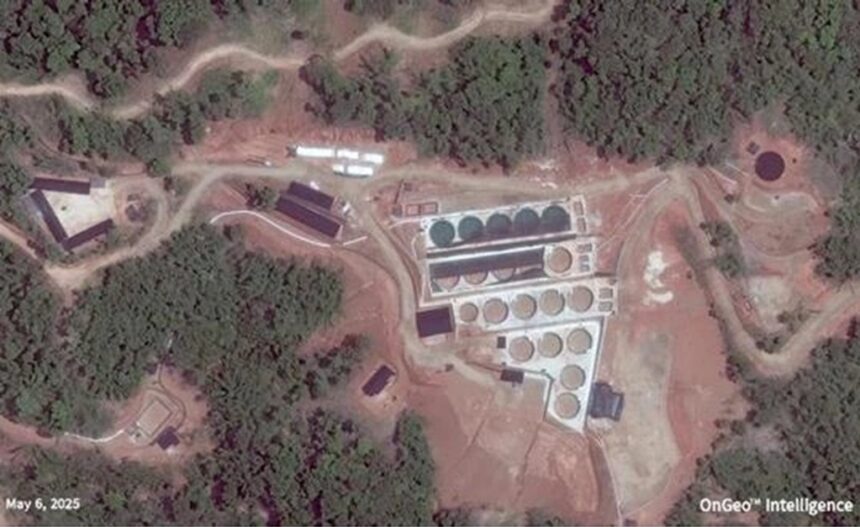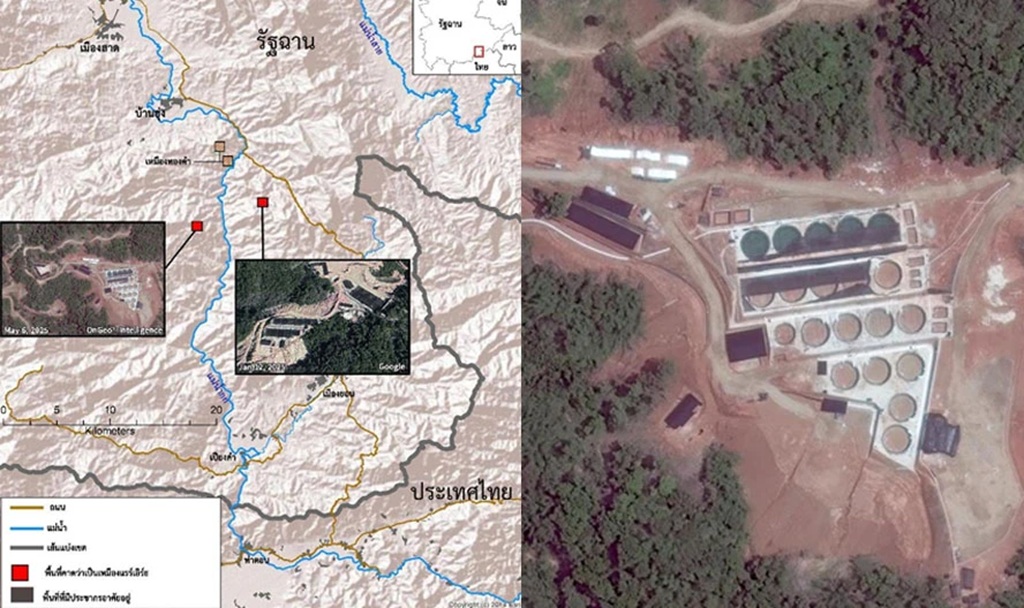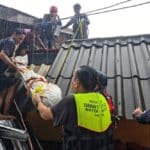CHIANG RAI — Residents in Chiang Mai and Chiang Rai have raised concerns over ongoing mining near the Kok and Sai Rivers, warning that the situation is worsening. It’s not just gold mining causing trouble, recent findings show rare earth mining has started less than three kilometres from the Kok River, raising fears of further pollution.
Last year, the Kok and Sai Rivers saw arsenic levels climb above safe standards, and there were major floods not seen before. Some say the gold mining operations in Myanmar’s Special Region 2, ruled by the Wa group, played a big part.
New satellite images released by a human rights group reveal that more than gold is being dug up. Rare earth mining—sought after by powerful countries—now takes place close to the river. The chemicals used in this process can leave behind toxic waste, adding to the risk of contamination.
The images identify two rare earth mines. One lies south of Mong Sat, about 25 kilometres from Thailand’s Mae Ai district. The other sits in the Yon area, also in Special Region 2. These mines display rows of round ponds, a setup typical for rare earth extraction.
This approach has been widely used in Kachin State by Chinese-run companies to extract minerals like terbium and dysprosium.
Rare earth mining involves pouring chemicals down hillsides to dissolve minerals, which then flow into collection ponds for further treatment. This process can have severe environmental impacts, polluting soil and water, and harming the local ecosystem.
Satellite pictures show rare earth mining east of the Kok River, about 3.6 kilometres from the waterway, since mid-2023. On the west side, mining started around mid-2024, just 2.6 kilometres from the river.
People first noticed these mines while tracking gold mining in Shan State. Satellite photos used for gold mine checks revealed the nearby rare earth sites. Gold is still mined using a different method along the Sai River in Mong Sat, but the rare earth sites are much closer to the Kok.
Reports from Kachin State show rare earth mining can cause landslides, water pollution, dead fish and animals, and contaminated soil and crops. These problems could soon affect communities along the river, from Mae Ai in Chiang Mai to Chiang Saen in Chiang Rai, where the water flows into the Mekong.
Locals and advocacy groups urge both countries to investigate and share updates with the public. Many want quick action to protect the rivers and ensure safe water for everyone living downstream.
Environmental Hazards of Rare Earth Mining
Rare earth mining poses significant environmental hazards due to the extraction and processing of rare earth elements (REEs).
1. **Toxic Waste and Pollution**: Mining and refining REEs generate large volumes of toxic and radioactive waste, including heavy metals, acids, and radioactive elements like thorium and uranium. For example, processing one ton of rare earths can produce up to 2,000 tons of toxic sludge, which, if mismanaged, contaminates soil, groundwater, and surface water.
2. **Water Contamination**: The use of chemicals like ammonium sulfate and acids in extraction processes often leads to wastewater discharge. In regions like Baotou, China, improper disposal has contaminated local water supplies, harming ecosystems and human health.
3. **Soil Degradation and Deforestation**: Open-pit mining and strip mining destroy vegetation, erode topsoil, and disrupt ecosystems. Large-scale deforestation and land clearing for mines reduce biodiversity and contribute to habitat loss.
4. **Air Pollution**: Dust from mining operations and emissions from processing facilities release particulate matter and toxic gases, affecting air quality and causing respiratory issues for nearby communities.
5. **High Energy and Carbon Footprint**: REE processing is energy-intensive, often relying on fossil fuels, which contributes to greenhouse gas emissions and climate change.
6. **Radioactive Byproducts**: Many rare earth deposits contain low levels of radioactive materials. Improper handling of tailings, as seen in sites like Bayan Obo, China, can lead to long-term environmental and health risks.
7. **Ecosystem Disruption**: Mining activities fragment habitats, displace wildlife, and alter water flows, impacting local flora and fauna. Acid mine drainage can further acidify streams, killing aquatic life.
**Mitigation Efforts**: Some solutions include stricter regulations, improved waste management, recycling of REEs from electronics, and developing greener extraction technologies. However, enforcement varies widely, especially in major producing countries like Myanmar.
Chinese rare earth mining operations in Myanmar, particularly for gold and jade, have been widely criticised for their environmental toll. Reports highlight deforestation, water pollution, and soil degradation in regions like Kachin and Shan States.
Cyanide and mercury used in gold mining are contaminating rivers, impacting local communities and cross-border waterways, such as the Mekong and rivers affecting Thailand. Rare earth mining, often in collaboration with local militias like the United Wa State Army (UWSA) or Kachin groups, has led to toxic sludge and scarred landscapes, with little regulatory oversight since Myanmar’s 2021 coup.
Related News:
The Wa Army in Myanmar Expands Gold Mining Despite Kok River Pollution















